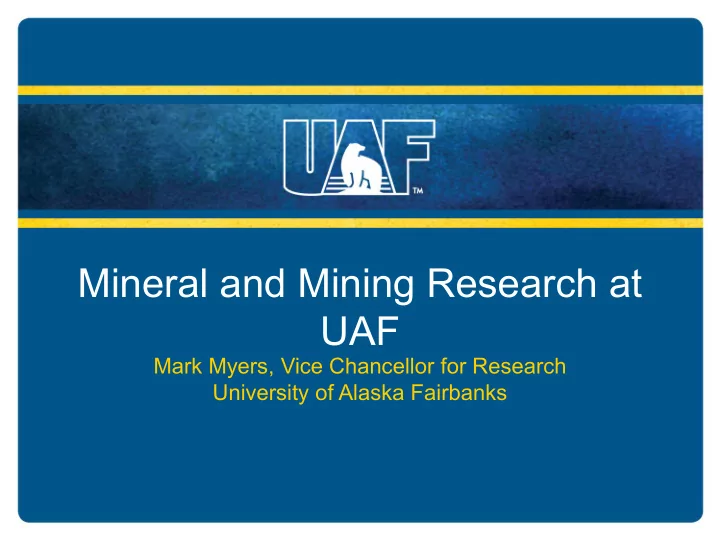

Mineral and Mining Research at UAF Mark Myers, Vice Chancellor for Research University of Alaska Fairbanks
UAF Has Research Expertise That Spans the Mining Cycle
UAF Mining and Mineral Expertise Mining Engineering Resource Estimation Permitting Issues Mine Design Exploration / Geology Mine Waste Management Rajive Ganguli (MGE) Anupma Prakash (GEO) Dave Barnes (CEE) Rainer Newberry (GEO) Sarah Hayes (CHEM) Ventilation Mary Keskinen (GEO) Tom Trainor (CHEM) Sukumar Bandopadhyay (MGE) Bernie Coakley (GEO) Bill Schnabel (WERC) Paul Metz (MGE) Ground Control Cathy Hanks (GEO/PETE) Ecology Gang Chen (MGE) Falk Huetmann (BIO) Scott Huang (MGE) Resource Modeling Anne Beaudreau (FISH) Rajive Ganguli (MGE) Ginny Eckert (FISH) Mine Safety Sarah Trainor - Human Dimensions Gang Chen Mineral Economics Katey Anthony - Lake Ecosystems Sukumar Bandopadhyay (MGE) Economics Matthew Wooller - Biology Rajive Ganguli (MGE) Paul Metz (MGE) Kenji Yoshikawa - Permafrost Dennis Steffy (UAS, MAPTS) Doug Reynolds (ECON) Junho Baek (ECON) Societal Impacts Mine Systems Ralph Gabrielli (RUR DEV) Rajive Ganguli (MGE) Policy Anna Berge (LING) Sukumar Bandopadhyay (MGE) Gary Kofinas (NRM) Maribeth Murray (NORS) Julie Joly (NRM) Susan Todd (NRM) Mine Technology Sarah Trainor (INE) Wireless Arctic / Cold Climate Phil Loring - Human Impacts Dejan Raskovic (ECE) Data & Algorithms Yuri Shur (CEE) Water Rajive Ganguli (MGE) Margaret Darrow (MGE) Bill Schnabel – WERC Vikas Sonwalker (ECE) John Zarling (CEM) Debu Misra - Hydrology Jason McNeely (ECE) Kenji Yoshikawa (INE) Ronnie Danaan - Hydrology Energy Doug Kane - Hydrology Rich Weis (ECE) Vo-Tech / Training Anna Liljedahl – Hydrology Billy Muhando (INE) Horacio Toniolo – Hydrology Diesel Mech Brian Rencher (CTC) Modeling of Impacts Tom Heinrichs - Remote Sensing Mineral Processing Dan Walsh (MIRL) Process Tech Scott Rupp - Climate Modeling Steve Lin (MIRL) Brian Ellingson (CTC) MSHA Training Dennis Steffy (UAS, MAPTS)
UAF Facilities A well-equipped coal laboratory is devoted to research and service activities on the characterization, petrography, distribution, and preparation of Alaska’s coals. The laboratory facilities at MIRL include: • Mineral Processing Lab • Hydrometallurgy Lab • Electrochemistry Lab • Analytical Lab • Coal Lab
UAF’s Advanced Instrumentation Laboratory. • CAMECA SX-50 Electron Microprobe • Atomic Force Microscope • Transmission Electron Microscope • Scanning Electron Microscope • X-Ray Fluorescence Spectrometer • X-Ray Diffraction • Fourier Transform Infrared Spectrometer • Inductively Coupled Plasma Mass Spectrometer
UAF Mineral Partnerships with State Agencies • DGGS Partnership – Exploration program • Mapping – Mineral processing studies • DGGS is currently using MIRL facilities for Ray Mountain rare earth study • DNR/DEC/Other – Permitting – Land Selection • DCCED – Targeted research to spur economic development – Intellectual Property
MIRL Capabilities: Mineral Processing – Coal – Metal/non-metal • Comminution • Flotation • Separation • Solvent extraction • Electrowinning Ventilation • Coal • Mine Ventilation Networks • Simulation
MIRL Capabilities: Strata Control • Rock testing – Frozen sample testing • Slope Stability • Frozen Ground Engineering • Finite element modeling • Basic Geotech Mine Design • Reserve Estimation • Block Modeling • 3D Mine Design
MIRL Capabilities: Hydrology • Underground hydrology • Contaminant flow through soils • Soil Properties • Hydrological Properties Other • Mineral Economics • Exploration Geophysics • GIS • Soil Engineering • Coal Gasification • Silver Fox Mine • Computational / Software development
UAF investing in new approaches to Mineral Exploration
What is Hyperspectral Mapping? • We use images acquired in 100s of narrow spectral regions (visible, infrared, thermal portion of the spectrum) to figure out in which parts of the spectrum the target is absorbing energy and where it is reflecting. Source: Green et al., 1998 • This absorption and reflection pattern (known as the spectral signature) is diagnostic for different materials • We use these spectral signatures to identify minerals, rocks, hydrocarbons, vegetation species, material types, etc. Source: CALTECH
Minerals Mapping • Technology let's us get down to the level of identifying mineral chemistry !!!!. – Iron-bearing minerals display most absorption features in visible to near-infrared – Minerals displaying SWIR absorption features include clays, phyllosilicates, carbonates – Minerals display diagnostic emission features in TIR Source: Mars and Rowan, 2003 Credits: Haselwimmer, derived from USG spectral library Credits: Haselwimmer, derived from USG spectral library
Google Maps AVIRIS mineral map Source: USGS Spectroscopy Lab Source: Google Maps Generalization of hydrocarbon seepage (Yang, 1999)
Minerals Mapping • Hydrothermal alteration of rocks produces characteristic zoned assemblages of minerals that can provide targets for mineral exploration
What if the target is not exposed ? • Use indirect indicators: geomorphology, vegetation, etc. Source: Hong Y., 2000
What if the target is not exposed ? Measuring Terrestrial Biosphere • Use indirect indicators: geomorphology, vegetation, etc. Species Map chamise, sagebrush, manzanita, mustard, Functional Type Map bigpod ceanothus, redheartceanothus, grass, coast live oak, scrub oak, California bay, yucca, soil, urban, unclassified Annual grass, annual herb, Evergreen broadleaf shrub, evergreen broadleaf tree, evergreen Source: Hong Y., 2000 needleleaf shrub, evergreen succulent, soil, urban, unclassified Credits: Dr. Roberts, HyspIRI 2002
Our capacity at UAF • We have in-house expertise in – understanding Alaska specific needs – hyperspectral data acquisition – scaling: from field to satellite scale – data processing & product generation • We need to invest in – partnership – new hyperspectral sensors – trained workforce for data processing – building Alaska specific spectral libraries Credits: Haselwimmer Source: Lammoglia & de Souza-Filho, 2011 Source: Clark et al., 2002 Credits: Hyspex
Thank You for Your Attention For more information contact: mdmyers@alaska.edu
Recommend
More recommend